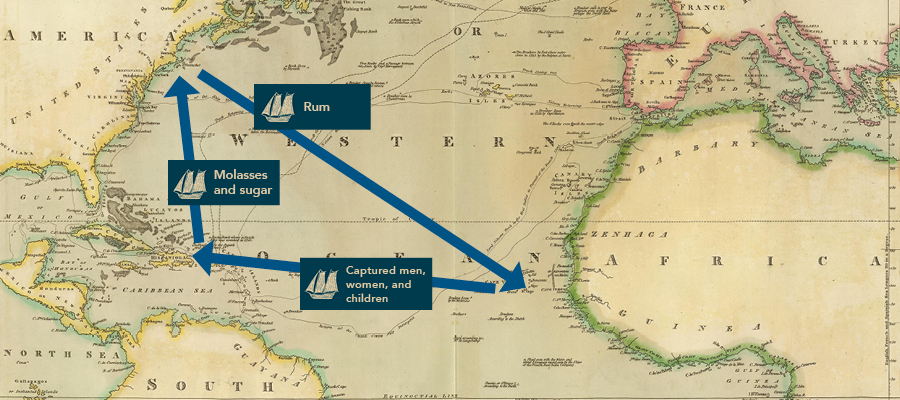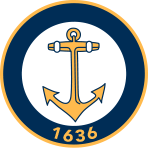Maritime Trade
Rhode Island, with its limited land and abundant harbors, relied heavily on maritime trade. Ships from around the world came to Rhode Island ports carrying goods that were sometimes used in the colony, and sometimes shipped elsewhere. Many Rhode Island ships were used in the trans-Atlantic slave trade, sometimes called the Triangle Trade, that brought thousands of men, women, and children from Africa to the Americas where they were forced into slavery.

It is called the Triangle Trade because the routes the ships took – between Rhode Island, Africa, and the West Indies - formed a triangle. A ship might begin in Rhode Island with a cargo of rum. From Rhode Island it sailed to the coast of Africa where its cargo of rum was traded for captured Africans. Sometimes the captives were alone; other times they were entire families. From Africa, the ships usually went to the West Indies or South America where they sold most of the captive Africans into slavery and took on new cargoes of sugar and molasses. The sugar, molasses, and remaining captives were brought to Rhode Island where the sugar and molasses were used to make rum, and the remaining captives were sold into slavery. The rum manufactured in Rhode Island was then sent to Africa to begin the cycle again.
Primary Source Documents
Click on the thumbnails below to zoom in and explore these documents.
-

A topographical chart of the bay of Narraganset in the province of New England, 1777
This is a copy of a 1777 chart of Narragansett Bay and the land around it. The original chart was based on surveys done in 1764 and 1774 by English military engineer Charles Blaskowitz. It is one of the most detailed charts of Narragansett Bay from the colonial period and includes information about the coastline and islands, military fortifications, and some of its port towns.
-

Manifest from Surinam, 1776
This manifest is from a sloop called Polly which came to Rhode Island from Surinam. Her cargo was molasses, cocoa, coffee, and a chest of “linnens and checks.” Although enslaved people are not listed here, these items were all tied to the trans-Atlantic slave trade. View additional manifests to read about other types of cargo.
-

Manifest from Hispaniola, 1776
This manifest is from a schooner called Defiance which came to Rhode Island from Hispaniola. Her cargo was molasses, sugar, coffee, German steel, fire arms, linen, and cambric (a kind of cloth). During the American Revolution many ships transported guns and ammunition. View additional manifests to read about other cargoes.
-

This page is from a book that recorded ships coming to Rhode Island and their cargoes. The ships on this page came from New York, Surinam, Baltimore, Cape Verde, and Cape Francis. Look at other pages to see the other ports visited by Rhode Island ships.
Questions and activities
-
What were the key locations in the Gaspee attack? Find them on the 1777 chart of Narragansett Bay.
-
How is the 1777 chart different than a contemporary map? How is it the same? Are there things on this map that don’t exist today? Are there places you know exist today that you can’t find on this map?
-
How did information and people travel in 18th century Rhode Island?
-
Look at the lines and numbers in the areas depicting water on the Narragansett Bay chart. What do you think they indicate? Watch this video from RI’s State Flag Ship Oliver Hazard Perry to learn more.
-
Use the manifests to see what was imported to and exported from Rhode Island in the 1700s. Make a list of the items you see and where they came from. Who do you think used these items, and how? (You can see more Manifests and Import Office Book pages in the State Archives’ Digital Archive.)
-
What can you learn about what people produced, bought, and sold in your town in the 1700s? How were those goods used to support the slave trade and the practice of slavery?
-
Does knowing about Rhode Island’s reliance on the trans-Atlantic slave trade make you question the motivations of the Gaspee attackers? Were they really patriots, or were they just protecting their profitable businesses?
